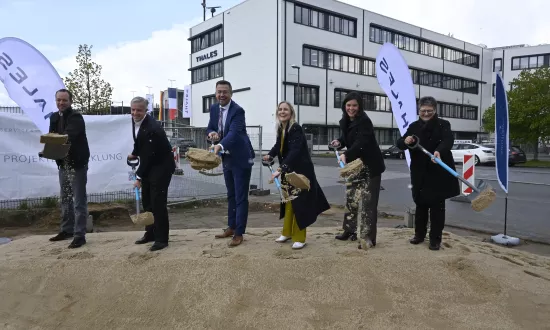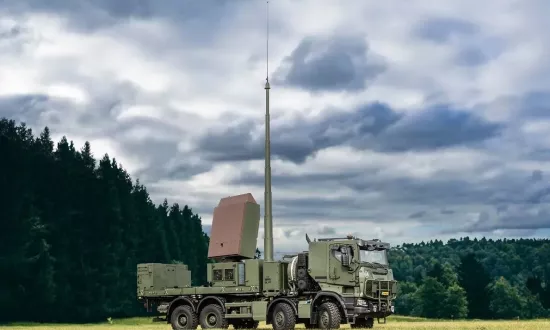Research trips for autonomous rail vehicles in the Elmstein valley in the Palatinate
Today, Markus Fritz from Thales Deutschland, in the presence of the Rhineland-Palatinate Minister for Labour, Social Affairs, Transformation and Digitalisation, Mr Alexander Schweitzer, and Mr Werner Schreiner from the Rhein-Neckar traffic association (VRN), as well as association director Michael Heilmann, administration union SPNV Rhineland-Palatinate South, presented the latest research findings on autonomously driving rail vehicles in Elmstein/Palatinate. Thales, a company located in Ditzingen near Stuttgart, chose the Elmstein valley for its digitalisation attempts, especially because of the geographical conditions.
Minister Schweitzer emphasised the importance of digitalisation projects for local public transport. "The 'Rheinland-Pfalz Takt' has laid an excellent foundation for an attractive local public transport which we can improve even further through digitalisation. The topic of autonomous driving is certainly one of the exciting topics for the future. I’m pleased that the mobile future lab is stopping here in the Palatinate today."
Basically, digitalisation includes all spheres of life and, in particular, offers locations outside the metropolitan areas a great opportunity. "Future-proof structures are of particular importance in a large state like Rhineland-Palatinate. A current example is the flooded area around the Ahr. Here, we are committed to develop the flooded region into a model region for fibre optic expansion and crisis-proof mobile network", said minister Schweitzer.
The progressing digitalisation is also of importance for railway tracks
The digitalisation of railway tracks will enable a ride without signalling technology and in the long term also without a train driver. Furthermore, a European control system, such as the ETCS – European Train Control System –, is also to be introduced on the rail tracks in southern Rhineland-Palatinate. All these things are also considered throughout the planning of the new cross-border rail services.
Markus Fritz, VP Main Line Signalling Domain Germany from Thales Deutschland adds: "New developments, changes to existing systems and products or launches of new technologies require comprehensive testing and validating activities. In practice, a large part of these activities is carried out as part of laboratory tests. Experience shows, however, that tests under real conditions must be an equally important part of verification, since not all conditions from real tracks can be mapped in the laboratory. On the route between Lambrecht and Elmstein, our test vehicle LUCY is used as a mobile laboratory for our national and international digitalisation projects."
Werner Schreiner from the VRN and co-initiator of the museum train Cuckoo Railway adds: "The 13-kilometre single-track railway line has the advantage that it’s usually only used operationally on weekends and public holidays and operates in its simplest way – according to the -simplified train control- procedure. As soon as a train enters the track, no further train may follow. This means that it’s ensured that there’s always just one train on the track. Therefore, test drives can take place flexibly. This operating procedure and the simplicity of the execution with which test drives are carried out are likely to be unique in Germany." The VRN supports all efforts to make an even more attractive offer by digitalising local public transport.
Currently, the so-called APS (Advanced Positioning System) is being tested as a new technology to ensure precise position detection of a rail vehicle. Here, sensors are included and the track has been equipped with 30 Eurobalises, information points in the railway track, which function as reference objects for position detection.
In August 2021, the line was completely topologically mapped by the French company GeoSat. For this, the infrastructure was measured with centimetre precision using a measuring system consisting of LIDAR, GPS and cameras. A digital map (HD map) is created from this data, which serves as reference for testing the APS sensors as well as other future systems.
The test drives are carried out with Thales’ own test vehicle LUCY, which offers ideal conditions as a test platform. The current developing statuses and the realisation in the context of the ETCS implementation can be presented here. The track allows an uncomplicated demonstration of ETCS L1, ETCS L2, ATO and FRMCS. Supported by the presentation options in the test vehicle LUCY, many aspects can be presented coherently. ETCS is a European train control system for the management, safety and protection of trains, which replaces numerous incompatible systems that were previously used on European railway tracks. FRMCS – Future Railway Mobile Communication System – is the successor of the railway-specific mobile radio standard GSM-R. ATO – Automatic Train Operation – means automated train operation in which the train control is completely or partially taken over by the on-board train computer.


